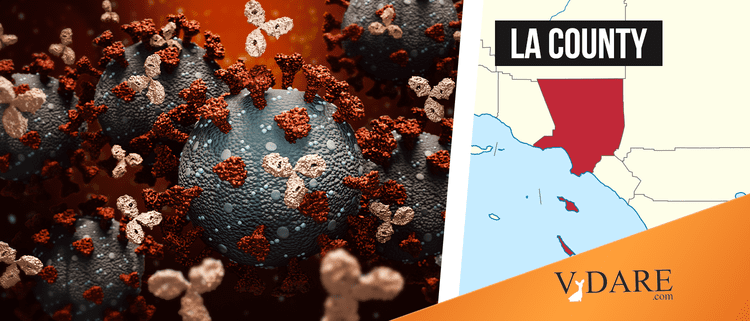Now USC has done an antibody test on 863 supposedly randomly representative individuals in Los Angeles County and come up with a best guess infection rate of 4.1%. This has most of the methodological problems associated with last week’s Stanford report that came up with a 3.1% best guess in Santa Clara County (Palo Alto and San Jose).
The leader of the new USC study, Neerad Sood, was a co-author on last Friday’s Stanford study. Here is stats professor Andrew Gelman’s critique of the Stanford study.
But, still … it’s another data point, which is helpful, and it fits in nicely with the Stanford result, because previously available evidence suggested LA County is somewhat harder hit than Santa Clara County. Both the Stanford and USC studies strike me as sounding about right: Single digit infection percentages is what I would have guessed ahead of time rather than zero digit or double digit infection rates.
From the Los Angeles Times:
Hundreds of thousands in L.A. County may have been infected with coronavirus, study finds
By MELANIE MASON STAFF WRITER
APRIL 20, 20201:12 PM UPDATED 2:29 PM
Hundreds of thousands of Los Angeles County residents may have been infected with the coronavirus by early April, far outpacing the number of officially confirmed cases, according to a report released Monday.
The initial results from the first large-scale study tracking the spread of the coronavirus in the county found that 2.8% to 5.6% of adults have antibodies to the virus in their blood, an indication of past exposure.
That translates to roughly 221,000 to 442,000 adults who have recovered from an infection, according to the researchers conducting the study, even though the county had reported fewer than 8,000 cases at that time.
For a long time, L.A. was one of the worst places in the country to try to get a coronavirus test if you weren’t a LeBron James level celebrity. So it was always known the L.A. County’s ten million people are undercounted badly for infections. (The current official number of cumulative CV cases in L.A. County is 13,823.)
On the other hand, Los Angeles’s death totals, while worse than in most of the rest of California, and its strain on hospitals haven’t been that bad by New York standards. L.A. County has 619 official CV deaths through today for 10 million people. (But the number of deaths keeps rising pretty fast, with a new record of 81 on last Saturday alone.) In general, while Northern California gives the impression of being largely out of the woods, Los Angeles does not. Things might still get bad.
In contrast, Santa Clara County (Silicon Valley) has had 83 CV deaths cumulative for almost 2 million people, so the death rate per capita in L.A. County is about 50% higher than in Santa Clara County, but much less awful than in the NYC area. So the notion that the LA infection percentage is about 30% higher than the SC percentage sounds … not implausible.
So LA currently has had 619 deaths and if it had, say, 325,000 infections by whatever the date of testing in early April was, that could be an Infection Fatality Rate of 0.2% (so far). This is in a pretty good situation for medical care with hospitals being far from overwhelmed and with doctors having access to the learning done by doctors in China, Italy, and New York.
The findings suggest the coronavirus is far more widespread than originally known, and that its fatality rate is much lower. But Sood cautioned against solely focusing on how lethal the disease is.
The early results from L.A. County come three days after Stanford researchers reported that the coronavirus appears to have circulated much more widely in Santa Clara County than previously thought.
The Stanford team estimated that 2.5% to 4.2% of Santa Clara County residents had antibodies to the coronavirus in their blood by early April.
Though the county had reported roughly 1,000 cases in early April, the Stanford researchers estimate the actual number was 48,000 to 81,000, or 50 to 85 times greater.
The Santa Clara study recruited around 3,300 participants from social media, which has raised some concerns that the results may not be representative of the county as a whole. The researchers made adjustments to their data to account for that problem.
The study was composed differently in Los Angeles; 863 adults were selected through a market research firm to represent the makeup of the county. The county and USC researchers intend to repeat the study every two to three weeks for several months, in order to track the trajectory of the virus’ spread.
Of course, the problem with USC’s sample of 863 is that it’s tiny for measuring something that appears to be in single digits. I haven’t found their paper yet online, but if 4.1% of 863 were positive, that’s only 35 positives, which is pretty tenuous. But better than nothing.
Both counties used rapid antibody tests supplied from Premier Biotech, a Minneapolis-based company.
A sizable problem is that there is no single Gold Standard test for coronavirus, so every test tries to validate itself against other tests that also have problems with false positives and false negatives. This isn’t an impossible problem to get around over time, but it should be kept in mind. As many critics of the Stanford study have pointed out, low incidence studies are kind of held hostage to the unknowns of false positives.
… Nevertheless, antibody tests have increasingly become a focal point in the response to coronavirus because they can potentially show the true extent of the virus’ reach and therefore can shed light on how close the population is to achieving herd immunity, in which enough people have some degree of immunity to the virus that it becomes difficult for infections to spread.
4.1% is a long way from herd immunity, which is usually thought to kick in somewhere over 50%.













